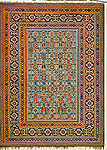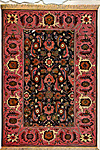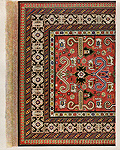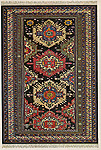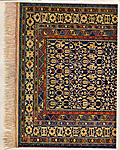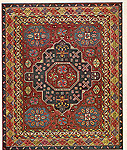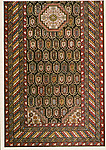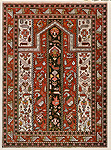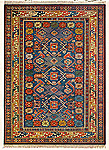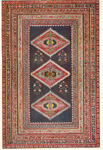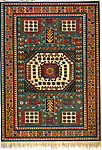
Return
to table of contents
| Return
to report
M.
D. ISEAV
May 2004
In the matter of carpets from Caucasia there is a significant bridge book, Carpet Production of the Transcaucasus, Scientific Research Institute, Caucasus Academy of Science, Tiflis, 1932, by M. D. Isaev, based on statistical and economic surveys. This book underlies the various publications of Kerimov, et. al., which run from the 1950's through the 1980's, and is the link between these latter day writings and the various reports concerning craft industry of the pre-revolutionary period.
They all are, unsurprisingly, consistent.
Isaev contains a great deal of information - too much - on carpet-making in the early Soviet period, heavily skewed to matters economic: numbers of workers, location of workers, weekly hours, income, and the like. While carpet cooperatives had begun in the mid-twenties and were developing in the period 1927 - 28, the activity was still predominately one of the villages and undertaken at home rather than in artels. The dominant production area, as historically was the case, was Azerbaijan (70%) followed by Armenia and Georgia (15% each). Much of this information is boring and of no interest to any but conscientious students; the message, however, is that after the collapse during the first world war and the ensuing civil war period, the activity revived, to considerable extent unchanged, with the assistance of Soviet apparatus which acted in support of craft industry exactly as did its imperial predecessors.
The materials herein are the guts of the Isaev book. First, the long geographic typology of weaving villages; second a set of some of the artist renditions of carpet patterns being furnished weavers. On this second matter, it may be useful to observe field patterns (the same as the earlier period) and design of border envelopes (different). A good approach might be to disregard the plethora of villages, while noting they are quite real, and that it is their numbers not their names, which is significant, for example, the 33 identified in Kuba district which squares with the 28 weaving villages cited in the kustar' survey of 1901. It is, rather, areas and their subdivisions which are meaningful.
One can read for details - the appearance of the misnomer, Marazali, (for Maraza) and the use of Gabistan as an area term. What is important, however, is the identification of Armenian weaving villages in Shirvan, and, the conversion under government sponsorship of the technics of pile rug construction in western Azerbaijan and in Armenia from traditional coarse weave to the finer more supple weave of eastern Azerbaijan, making it possible to identify examples of this type. (The Textile Museum has a couple of the latter, but doesn't know it.)
Now, as for the typology as it appears in Isaev. The transliteration sticks with the Russian. For "dzh" substitute "j"; the rest of it aligns fairly well with the underlying place name, typically Azeri. K's and g's occasionally get transposed, as do b's and p's. Only one or two government political jurisdictional terms appear; the minor ones, such as police districts, are translated as "area" and its synonyms. "Vicinity", however, is preserved; "center" is used for a word which literally means "node" or cluster of small villages, commonly used in western Azerbaijan and Armenia. Parens appear in the text; brackets are editorial inserts.
A. BROAD VIEW OF PILE CARPETS WITH THIN YARN AND SHORT CLIPPED PILE
In the following common groups (areas)
I. Kuba, consisting of types (subareas)
a. mountain zone,
including the principal villages: Konakend-Khyashi, Giumiurdakhna, Ugakh,
Charakh, Budug, Seiub, Dzhimi, Kryz, Afrdzha, Erfi;
b. foothill and hilly zone with the villages: Pirebedil, Zeiva, Dere-Chi-Chi,
Gyando, Bilidzhi, Shakhnazarly, Piramsan, Leity, Alikhanly, Amirkhanly,
Findgan, Khalfalyar, and, separately in the south-west from the mountains
Kuba-Miugiuch, Tekhya, Alpan, Tiulyakyaram;
c. plains zone with the villages: Adzhi-Karagashly, Chai-Karagashly, Sinsanny-Karagashly,
Sarvan, Devechi, Mollakemally, Mikrakh, Perdikran, Makhsudkend (the last
three in the northern part of the plains)
II. Baku in types (subareas)
a. upland part Baku
district (Khyzyn section) in the villages: Kyzy, Gaadi, Gevkhanly, Zarat,
Kesh, Khal;
b. Apsheron peninsula in the villages: Kala, Surakhany, Khila, Novkhany,
Fatmai, Nardalan.
III. Shirvan in types (subareas):
a. Gabistan in the
villages: Chukhanly, Marazaly, Siundi, Navur, Uduly, Pashaly, Shorbakhcha;
b. Akhsuin - all of the hilly part of Shirvan area in the villages: Bidzhov,
Geoglyar, Lengebiuz;
c. Kiurdamir - all of the lower part of Shirvan district in the villages:
Kiurdamir, Ismaily, Sorsor, Shil'yan, Mollakend, Pirasanny, Padar;
d. Sal'yano-Adzhikabul' in the villages: Khila, Karbagly, Khaladzh, Chalogly,
Dzhagirly, Kelany
IV. Lesghi in types (sub-areas):
a. Lesgistan in the
villages: Gil, Yasab, Piral, Khazry, Immankulikend, N. Zeikhor, Kevna,
Khudaat, Annyku;
b. northern part of the Kutkash area in the villages: Kamerovan, Kaladzhik,
Durudzha, Fil'fili, Karabular, Seveyagyan.
In this overview of thin and low pile carpets independent branch types stand out:
1. Karamar'ya (or
Ermen Shirvan), embracing the Armenian villages of Karamar'ya area - Kirk,
Kalagya, Ushtal;
2. Karadon village, Sal'yan area, making so called Mughan carpets;
3. Talysh, in Lenkoan district, in the villages: Assaly, Adzhiismailly
(Astrakhan Bazar area), Seidbazar, Dzheferly, Astanly, Zokup (Vergeduz
area).
B. BROAD VIEW OF CARPETS WITH THICK YARN AND HIGH CUT PILE
In the following common groups (areas)
I. Karabakh in types (subareas):
a. Shusha city
b. villages of the Autonomous Oblast of Nagorno Karabakh: Dashbulag, Dovshanly,
Garov, Trnavaz (Red Village), Melibeily, Chankhchi, Tukh, Taglar, Gadrut;
c. Kiurdistan in the villages: Muradkhanly, Kasim-Ushagy, Kubatly, Gochaz,
Minkend, Bagrbeily.
In the past these types were regarded as the production of Zangezur, Daralagez and Bazargechara (Armeniya), which nowadays were reorganized with other principal carpet-making sub-areas of Armenia, switching to the making of thinner and lower pile output type of Kuba and Shirvan.
d. Khannykh in the
villages: Khanlykh, Tumas;
e. Dzhebrail' in the villages: Dzhebrail', Goradiz, Bagmanly;
f. lowlying [area] near the Kur [river] in the villages: Kengerly, Klyshly,
Tyaklya
II. Gyandzha in types (subareas):
a. plains zone in
the villages: (Karadzhamiry, Fakhralo, Panakhlar, Krmyzy-Karakhlar;
b. armenian villages of the hilly zone - Chaikend, Mirzik, Karabulag,
Murut, Erkech, Karakeshish;
c. turkish villages of the hilly zone: Togana, Todan, Sarisis;
d. Samur in the villages: Kazakhly, Kyasaman, Poily
III Kazak in types
(subareas):
a. Kazak proper consisting of the centers: Dashsaloglin (Dashsalogy, Damiurchilar,
Kesalar, Chaily), Saloglin (Shikhly 1 and 2, Kaimakhly, Verkhnie, middle
and lower Salogly), Akstafa (Dagkesaman, Krakhkecaman, Poily, Akhkevnak,
Karapanakhly:
b. Tauz in the villages: Oksiuzly, Bozanganly, Khatunly, Ashagakushi;
c. Borchalo-Karayaz (Georgia) in the centers: Borchali (Aukhlo, Kuttar, Kzyladzhly, Kachagan), self-contained and also Lembalo (Armenia), Karayaz, (Kiusaly, Nazarly) and Karachop (Tiullyar, Lembalo).
IV. The group (area) of Armenian carpets
The production of Armenia reorganized itself from thick yarns and high pile, of the Kazak family, into a manufacture of thin yarns, with low clipping, the Kuba, Shirvan, Baku type. Here are included the following subareas:
a. Lori in the villages:
Ardvi, Bert, Ledzhan, Agarak;
b. Bambaki in the villages: Shokh, Uzunlyar, Akhpat, Dseg;
c. Idzhevano-Shamshadin: Idzhvan ((Karavansarai) and the villages Verkhnii
Agdan, Khashtarak, Sevkar, Dzharkhech, Tauzkala, Ardanysh, Dzhil, Agbulakh,
and also the villages in the direction of Karakoin gorge (Chalkend, Gel'kend);
d. Zangezur, in the villages: Dyg, Khdozoresk, Goris city (Gerinsin center),
next to a village along the river Okhchi-chai (Kafan center) and the hamlet
Brnagod (Sisian center);
e. Daralag, Basargechar and New Leninikan center, not including other
subareas;
f. kurdish carpets of Armenia - the Argats mountain area (Alagez)
C. VILLAGES OF PILELESS CARPET PRODUCTION
1. Sumakhs: Lezgistan
(the hamlets Gil, Yasab, Piral, Immankulikend.
2. Verni, zili, shatda:
a. Gaady village
(Baku area)
b. Dzhebrail' and Prikurin subarea of Karabakh area;
c. Kazak area proper (Salogly village)
3. Kilims: Gabistan,
Karabakh, Aragats (Kurdish yamani) and Sal'yany
4. Mafrash and khurdzhins:
a. from figured fabric
kaiekh - Kyzyn section, Gabistan, Karabakh, Kazak;
b. from kilim fabric - everywhere, in all carpet-making areas of the Transcaucasus
republic
5. diverse products:
a. Kurdish shikhi
(curtains) [reed screens] products - Aragats (Alagez)
b. gerkyan - narrow fabric strips of great length, serving as a reinforcement
of packs for horses, camels, mules - with nomads
6. dzhedzhimy
(Note: According to production technique dzhedzhims do not appear in carpet-making; they more properly are attributed to ordinary fabric-making.)
a. Figured, out of
silk kamiyan - in Zardobsk settlements of Shirvan okrug and in the villages
of Lembaran, Karabakh okrug
b. plain - from silk saya -- primarily in the same areas
c. woolens - Kazak, Karabakh, Armenia
d. cottons - are made, primarily, by kustar'cooperatives in Erivan and
Tiflis.
From the Isaev typology it is clear that the craft industry apparatus was not much interested in non-pile weaving, about 10% of the pre-revolutionary product.
Here follows the artist renditions of approved designs of which there were either 50 or 70 (number not yet clear). It is a good idea to think the field pattern was traditional for the cited village, but not safe to assume it was made only there. Printed in Tiflis, 1n 1932, the colors are very likely not to be true. The term gyaba refers to a rug, largish and intermediate between scatter rugs and hali.
One of the foregoing
details is worth noting, that having to do with the
thick yarn, high pile category and one of its categories, Shusha City.
The entry "Carpet from Shusha City" discusses a rug of quite
different
style -- large, specially commissioned, and not at all the Karabagh
country type. These carpets can be documented from the late 19th
century into the pre-war 20th. That they had disappeared by the time
Isaev summed things up in 1930 can readily be seen, and the cause, World
War I and ensuing civil war in Caucasia, is easily deduced. That things
change over time is an iron law, and it is a fatal error to take the
circumstance of any given point and to project it back into history.
For example, Cecil Edwards knew an enormous amount about early 20th
century weaving in Hamadan, but blundered when he asserted that prior
to
then there had been no rug-making there, definitely not the case.
| Return to top |
